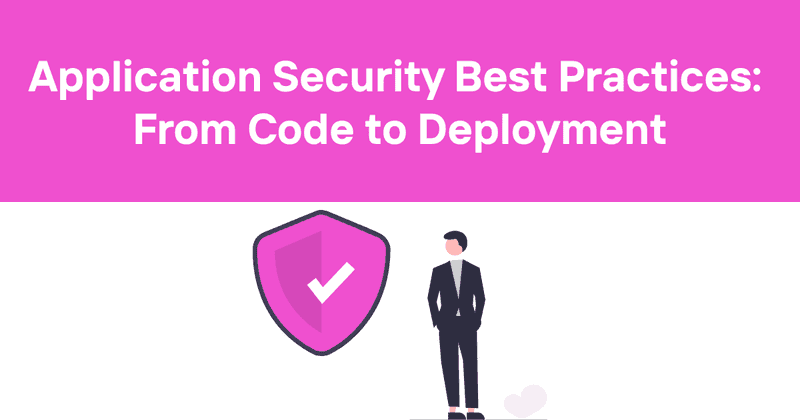Application Security Best Practices: From Code to Deployment
Security isn't just a checkbox—it's the foundation of reliable software. As cyber threats evolve and attack surfaces expand, application security demands a proactive approach throughout the development lifecycle.
I've spent years watching organizations scramble after security incidents that could have been prevented. The most successful teams build security into their processes from day one instead of bolting it on at the end.
Let's explore practical, actionable strategies to protect your applications from modern threats.
Table of Contents
Understanding Application Security Challenges
Building secure applications has never been more challenging. New frameworks emerge monthly, third-party dependencies fill our codebases, and deployment pipelines move faster than ever.
The threat landscape continues to evolve too. What worked five years ago simply doesn't cut it today. Applications now face sophisticated attacks from various vectors:
- Supply chain compromises: Attackers target upstream dependencies your application relies on
- Zero-day vulnerabilities: Unknown flaws exploited before patches exist
- API-specific attacks: Unique vulnerabilities in the connective tissue between services
- Social engineering tactics: Human manipulation to gain access credentials
- Automated scanning and exploitation: Bots constantly probing for weaknesses
An alarming statistic: over 70% of applications have security flaws that could be exploited. And the average cost of a data breach? $4.45 million according to recent IBM research.
I've seen startups crumble after security incidents destroyed customer trust. I've also watched large enterprises pay millions in regulatory fines that could have been avoided with basic security practices.
Security isn't just about avoiding breaches—it's about building trust with your users and protecting your business.
Secure Development Lifecycle Practices
Security must be woven throughout your development process, not tacked on at the end. This "shift-left" approach catches vulnerabilities earlier when they're cheaper and easier to fix.
Start with security requirements gathering. Ask questions like:
- What data will the application process?
- What are the potential security threats?
- Which compliance regulations apply?
Then move to threat modeling—identifying how attackers might target your application and planning countermeasures. This isn't a one-time activity but should be revisited as features evolve.
When designing architecture, follow these principles:
- Defense in depth: Multiple security layers so no single failure exposes the system
- Least privilege: Components only have access to what they absolutely need
- Fail securely: When errors occur, default to secure states
Bake security checkpoints into your CI/CD pipeline. This means automated security testing integrated directly into your build and deployment process. No code should reach production without passing security gates.
Documentation matters too. Maintain up-to-date security documentation including:
- Security architecture diagrams
- Data flow mappings
- Threat models
- Security controls inventory
Some teams I've worked with include security user stories alongside functional requirements. This makes security visible throughout planning and implementation rather than an afterthought.
Code-Level Security Practices
Let's get practical about secure coding. These aren't abstract concepts—they're specific techniques that tangibly reduce risk.
Input Validation
Never trust user input. Period. Validate all data against strict schemas:
- Define allowed characters, formats, and ranges
- Validate on both client and server sides
- Use whitelisting (specifying what's allowed) instead of blacklisting (what's forbidden)
I once saw an application compromised because it allowed users to upload profile images without proper validation—attackers uploaded executable code instead.
Output Encoding
Context-appropriate encoding prevents injection attacks:
- For HTML contexts, use HTML entity encoding
- For JavaScript, use JavaScript escaping
- For SQL queries, use parameterized statements
Dependency Management
Your code is only as secure as its dependencies:
- Maintain a software bill of materials (SBOM)
- Regularly scan for vulnerable dependencies
- Set up automated alerts for security updates
- Pin dependency versions where appropriate
Should you update dependencies immediately when vulnerabilities are found? Generally yes, but context matters. I've seen rush patches introduce worse problems. Test thoroughly, but don't delay unnecessarily.
Secure Coding Frameworks
Don't reinvent security wheels. Use battle-tested frameworks and libraries that implement security best practices:
| Type | Examples | Benefits |
|---|---|---|
| Web Frameworks | Spring Security, Django, Laravel | Built-in protection against common vulnerabilities |
| Authentication | Auth0, Okta, Keycloak | Professionally maintained identity solutions |
| Cryptography | NaCl, Tink, Libsodium | Safer cryptography APIs that prevent common mistakes |
The rule of thumb: security is hard, so leverage the collective wisdom embedded in well-maintained frameworks.
Authentication and Authorization
Getting identity right is fundamental. Most breaches involve authentication failures.
For authentication, implement:
- Multi-factor authentication (MFA) wherever possible
- Strong password policies with modern guidelines
- Secure password storage using algorithms like Argon2id
- Account lockout after failed attempts (but beware of DoS risks)
- Session management with secure cookies and appropriate timeouts
Authorization requires similar care:
- Role-based access control (RBAC) with clearly defined permissions
- Attribute-based access control (ABAC) for complex scenarios
- Regular access reviews and principle of least privilege
- API authorization using OAuth 2.0 and scopes
Don't forget about secure credential management:
- Never hardcode credentials in source code
- Use environment variables or dedicated secret management tools
- Rotate secrets regularly, especially after team member departures
One common mistake I see: implementing authorization checks at the UI level but forgetting to enforce them in the API layer. Remember that attackers can bypass your frontend entirely.
Data Protection Strategies
Data protection involves both data at rest and data in transit.
For data at rest:
- Encrypt sensitive data using industry-standard algorithms
- Use envelope encryption for database fields
- Consider data tokenization for PII
- Implement database activity monitoring
For data in transit:
- Use TLS 1.3 for all communications
- Configure perfect forward secrecy
- Enable HSTS for web applications
- Properly validate certificates
Data classification helps prioritize protection efforts:
- Public data - minimal protection needed
- Internal data - basic protection needed
- Confidential data - strong protection required
- Regulated data - maximum protection mandatory
And what about data minimization? Collect only what you need. The data you don't store can't be breached.
An often-overlooked aspect: secure data deletion. When data is no longer needed, ensure it's properly purged from all systems including backups.
Security Testing Methodologies
Testing reveals what theory misses. Implement multiple testing methodologies:
Static Application Security Testing (SAST)
SAST tools analyze source code for security vulnerabilities without executing it:
- Integrate into CI/CD pipeline
- Focus on what developers control directly
- Catches issues early in development
Tools like SonarQube, Checkmarx, and GitHub Advanced Security work well, but they generate false positives. Don't treat every finding as an emergency—triage intelligently.
Dynamic Application Security Testing (DAST)
DAST tools test running applications by simulating attacks:
- Finds runtime issues SAST might miss
- Works without access to source code
- Tests actual deployed environments
OWASP ZAP and Burp Suite are popular options here.
Interactive Application Security Testing (IAST)
IAST combines elements of both SAST and DAST:
- Instruments applications during runtime
- Provides detailed vulnerability information
- Reduces false positives
Penetration Testing
Human testers find what automated tools miss:
- Conduct regular penetration tests
- Use both internal and external testers
- Focus on business logic flaws
I recommend at least annual penetration tests by qualified professionals, with additional testing after major architecture changes.
Security Code Reviews
Human code reviews with a security focus catch subtle issues:
- Train developers on security code review techniques
- Use security checklists during reviews
- Focus extra attention on security-critical components
A security code review once saved my team from a subtle authorization bug that would have exposed sensitive customer data. No automated tool caught it.
Runtime Protection
What happens after deployment? Runtime protection forms your last line of defense.
Web Application Firewalls (WAF)
WAFs filter malicious HTTP traffic:
- Block known attack patterns
- Protect against OWASP Top 10 attacks
- Provide virtual patching for vulnerabilities
Modern WAFs like Cloudflare, AWS WAF, or ModSecurity offer good protection, but they're not perfect. Don't rely solely on WAFs.
Runtime Application Self-Protection (RASP)
RASP integrates security directly into applications:
- Detects attacks in real-time
- Blocks exploitation attempts
- Provides detailed attack telemetry
Unlike WAFs, RASP operates within the application context, giving it deeper visibility into application behavior.
API Gateway Security
API gateways provide centralized protection for APIs:
- Authentication and authorization
- Rate limiting to prevent abuse
- Request validation and transformation
Building a secure application means planning for attacks and containing their impact when they succeed. Defense in depth matters.
Container and Cloud Security
Modern applications often run in containers and cloud environments, bringing unique security challenges.
For container security:
- Use minimal base images to reduce attack surface
- Scan container images for vulnerabilities
- Run containers with non-root users
- Implement container runtime security monitoring
- Use read-only file systems where possible
For cloud security:
- Follow the shared responsibility model
- Use infrastructure as code with security guardrails
- Implement strong IAM policies and role separation
- Enable cloud provider security features
- Regularly audit cloud resources and permissions
Managed services can simplify security, but they don't absolve you of responsibility. Know what your provider handles and what remains your obligation.
Don't forget about secure CI/CD pipelines:
- Protect access to build systems
- Verify the integrity of dependencies
- Sign builds and verify signatures
- Implement separation of duties
The security of your production environment depends on the security of your deployment pipeline. One compromised build server can undermine everything else.
Security Monitoring and Response
Even with the best preventive controls, monitoring and response capabilities are essential.
Implement comprehensive logging:
- Log authentication events, authorization decisions, and input validation failures
- Include contextual information but sanitize sensitive data
- Establish centralized log management with retention policies
- Ensure logs are tamper-evident
Set up real-time monitoring:
- Define security-relevant alerts
- Establish alert thresholds to reduce noise
- Create playbooks for common security events
- Implement automated response for known threat patterns
Develop an incident response plan before you need it:
- Define roles and responsibilities
- Establish communication channels
- Create containment strategies
- Practice with tabletop exercises and simulations
The goal isn't just detection but rapid response. The average time to identify a breach is 197 days. How quickly could your team respond?
Team Security Culture
Technical controls matter, but human factors often determine security outcomes.
Build a positive security culture:
- Make security training relevant and engaging
- Recognize and reward secure behavior
- Provide clear security guidelines and resources
- Foster psychological safety for reporting issues
Create security champions within development teams:
- Identify security-minded developers
- Provide extra training and resources
- Empower them to advocate for security
Secure communication practices matter too:
- Use encrypted communication channels
- Establish policies for discussing sensitive information
- Create secure channels for reporting vulnerabilities
Security shouldn't be a department that says "no"—it should be a collaborative function that enables the business to move quickly and safely.
Regulatory Compliance
Different industries face different compliance requirements. Common frameworks include:
- GDPR for processing EU resident data
- HIPAA for healthcare information
- PCI DSS for payment card data
- SOC 2 for service organizations
Approaching compliance strategically:
- Map requirements to technical controls
- Implement a common control framework
- Automate compliance checking where possible
- Maintain evidence of compliance
Compliance isn't security, but it provides a baseline. The most effective approach treats compliance as a minimum requirement, not the end goal.
Don't overlook privacy requirements:
- Implement data subject access rights
- Maintain privacy notices
- Consider privacy by design principles
- Conduct privacy impact assessments
The regulatory landscape continues to evolve. Stay informed about emerging requirements in your industry.
How Odown Helps with Application Security
Security monitoring is a critical component of any application security strategy, and this is where Odown shines.
Odown provides comprehensive uptime monitoring for both websites and APIs, giving you immediate visibility into service disruptions that could indicate security incidents. When security breaches occur, they often manifest as availability issues before they're identified as security problems.
The SSL certificate monitoring feature is particularly valuable for security. Expired SSL certificates not only cause browser warnings but create security vulnerabilities. Odown tracks certificate expiration dates and alerts you before they expire, preventing security gaps and maintaining user trust.
Public status pages from Odown enhance security transparency. During security incidents, clear communication is essential. Odown's status pages allow you to keep users informed during security events, building trust even during challenging situations.
Some security-focused benefits of using Odown include:
- Early detection of unusual downtime patterns that might indicate DDoS attacks
- Verification that security patches and updates don't impact application availability
- Monitoring of security-critical API endpoints
- Alerting when SSL configuration issues are detected
- Documentation of security incident timelines through status page integration
While no single tool addresses all security needs, Odown provides essential visibility into the availability and integrity of your applications—key aspects of a comprehensive security strategy.
Final Thoughts
Application security isn't a destination but a journey. Threats evolve, technologies change, and teams must adapt continuously.
The practices outlined here provide a foundation, but effective security requires ongoing vigilance and improvement. Start with the basics, build incrementally, and prioritize based on your specific risks.
Remember that perfect security doesn't exist. The goal is to make attacks sufficiently difficult and costly that attackers move to easier targets, while having strong detection and response capabilities for when preventive measures fail.
Security and development aren't opposing forces. The best teams integrate security into development processes seamlessly, making it part of the definition of quality rather than a separate concern.
By implementing these application security best practices, you'll build more resilient applications, protect your users' data, and safeguard your organization's reputation in an increasingly hostile digital landscape.



